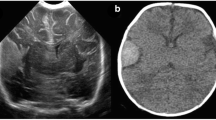Abstract
Juvenile xanthogranuloma (JXG) is a benign, self-limiting histiocytic disorder of infancy and early childhood, usually presented as a single or multiple cutaneous lesions. The central nervous system is rarely affected by JXG. There were only a few reports of intracranial JXG cases which described its features on MR spectroscopy (MRS) and diffusion-weighted imaging (DWI), but its features on susceptibility-weighted imaging (SWI) and perfusion-weighted imaging (PWI) have not been reported yet. Here, we reported an intracranial JXG case which underwent multimodal MRI examinations including DWI, SWI, and PWI. The multimodal MRI provided a thorough insight into this disease and we found that intense enhancement and high perfusion may be important clues for the diagnosis.




Similar content being viewed by others
References
Auvin S, Cuvellier JM, Defoort-Dhellemes S et al (2008) Subdural effusion in a CNS involvement of systemic juvenile xanthogranuloma: a case report treated with vinblastin. Brain Dev 30(2):164–168
Wang B, Jin H, Zhao Y et al (2016) The clinical diagnosis and management options for intracranial juvenile xanthogranuloma in children: based on four cases and another 39 patients in the literature. Acta Neurochir 158(7):1–9
Chiba K, Aihara Y, Eguchi S, Tanaka M, Komori T, Nakazato Y, Okada Y (2013) Diagnostic and management difficulties in a case of multiple intracranial juvenile xanthogranuloma. Childs Nerv Syst 29(6):1039–1045
Jr AW, Narayan P, Park TS et al (2005) Incidental pediatric intraparenchymal xanthogranuloma: case report and review of the literature. J Neurosurg 102(3):307–310
Matsubara K, Mori H, Hirai N, Yasukawa K, Honda T, Takanashi JI (2016) Elevated taurine and glutamate in cerebral juvenile xanthogranuloma on MR spectroscopy [J]. Brain Dev 38(10):964–967
Cianfoni A, Wintermark M, Piludu F, D’Alessandris QG, Lauriola L, Visocchi M, Colosimo C (2008) Morphological and functional MR imaging of Lhermitte–Duclos disease with pathology correlate [J]. J Neuroradiol 35(5):297–300
Matsubara K, Mori H, Hirai N, Yasukawa K, Honda T, Takanashi JI (2016) Elevated taurine and glutamate in cerebral juvenile xanthogranuloma on MR spectroscopy. Brain Dev 38(10):964–967
Techavichit P, Sosothikul D, Chaichana T, Teerapakpinyo C, Thorner PS, Shuangshoti S (2017) BRAF V600E mutation in pediatric intracranial and cranial juvenile xanthogranuloma. Hum Pathol 69:118–122
Author information
Authors and Affiliations
Corresponding author
Ethics declarations
Conflict of interest
We declare that we do not have any commercial or associative interest that represents a conflict of interest in connection with the work submitted.
Additional information
Publisher’s note
Springer Nature remains neutral with regard to jurisdictional claims in published maps and institutional affiliations.
Rights and permissions
About this article
Cite this article
Su, J., Chen, N., Yue, Q. et al. Multimodel MRI features of an intracranial juvenile Xanthogranuloma. Childs Nerv Syst 35, 871–874 (2019). https://doi.org/10.1007/s00381-019-04102-6
Received:
Accepted:
Published:
Issue Date:
DOI: https://doi.org/10.1007/s00381-019-04102-6




